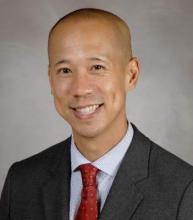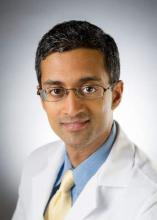With the widespread adoption of transcatheter aortic valve replacement and the public’s embrace of minimally invasive procedures, cardiac surgeons must adapt to stay relevant in the future, and that means acquiring skills to perform percutaneous procedures, Dr. Tom C. Nguyen and Dr. Isaac George wrote in the Young Surgeon column in the May issue of the Journal of Thoracic and Cardiovascular Surgery.
Drawing upon their own year in a structural heart endovascular fellowship, Dr. Nguyen and Dr. George called for a new approach to surgical training that encompasses percutaneous technology and procedures, “with a caveat that failure to do so will exclude surgeons from treating valve disease altogether in the future” (J. Thorac. Cardiovasc. Surg. 2015;149:675-77 [doi: 10.1016/j.jtcvs.2014.11.091]).
In making their case, Dr. Nguyen and Dr. George invoked psychologist Abraham Maslow’s “law of the instrument”: “I suppose it is tempting, if the only tool you have is a hammer, to treat everything as if it were a nail.” Dr. Nguyen is with the University of Texas and Memorial Hermann Heart and Vascular Institute in Houston. Dr. George is with New York-Presbyterian Hospital and Columbia University in New York.
Cardiac surgeons must break out of that mindset and learn from the evolution of vascular surgery, which was once the domain of general surgery but then evolved into its own specialty. Patients with peripheral vascular disease who were once surgical candidates instead opted for less-invasive endovascular procedures as interventional radiology techniques advanced. “This direction may have had devastating consequences for vascular surgeons if it were not for their ability and willingness to learn new skills so that they could also perform catheter-based interventions,” Dr. Nguyen and Dr. George wrote.
Catheter-based treatment for heart valve disease is following a similar path, but that doesn’t mean cardiac surgeons should vacate this field to cardiologists. “In fact, in order to provide the best comprehensive care for patients, a collaborative heart team including cardiologists and surgeons who all are equally proficient in endovascular techniques is essential,” they wrote. Further, if surgeons can work independently of cardiologists by learning and adopting percutaneous techniques, new technologies will advance even faster. “Surgeons have an intimate knowledge of the heart that is unmatched by any specialty; translation of this knowledge into structural heart valve technology is logical and needed,” Dr. Nguyen and Dr. George said.
Also, surgeons well versed in all techniques – endovascular, minimally invasive surgery, and conventional surgery – will be equipped to objectively offer the procedure that’s best suited for the patient rather than their own skill set.
Acquiring percutaneous skills, however, poses a high hurdle for cardiac surgeons. They must be able to perform the entire transapical and transaortic transcatheter aortic valve replacement (TAVR) procedure and seize the lead for the procedure from the cardiologist, Dr. Nguyen and Dr. George said. “To do this, surgeons will have to change their mindset regarding their role in the procedure and be willing to learn the technology.”
The minimum time commitment to learn these procedures is 6 months; for residents, a dedicated structural heart fellowship can take up to a year. The 20 interventional procedures that graduates are now required to perform “is not nearly enough,” they wrote.
Because percutaneous skills also apply to all future structural heart interventions, such as percutaneous mitral valve repair and replacement, percutaneous tricuspid valve repair and replacement, and pulmonic valve replacement, they can help the cardiac surgeon get past seeing valvular heart disease as something other than a nail.
The authors reported having no disclosures.



